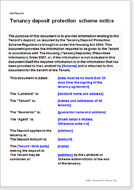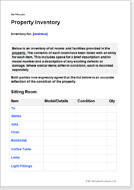About each assured shorthold tenancy agreement template
Each of these documents creates an assured shorthold tenancy.
To make property management easier, each of our agreements includes another 11 commonly used notices, forms and letters, each with its own notes and the notices with draft completed text.
That makes the pack of property documents convenient for private landlords and agents and extremely good value.
With each assured shorthold tenancy agreement template, we include:
- Form 6A: which replaces Section 21(1) or (4) notice to terminate a tenancy
- a Section 8 notice for possession
- a security deposit rent receipt
- a form to record the details of the deposit protection scheme
- a letter warning of late payment of rent
- a letter claiming rent arrears
- a letter to the Housing Benefit Department
- a draft inventory (with explanatory notes on how to use)
- a cold weather letter to remind tenants to ventilate and heat the property
- a smoke and carbon monoxide detector release letter and form
Strong legal protection for landlords
Residential tenancy law favours the tenant rather than the landlord. The key to letting safely is to have a tenancy agreement that protects your rights as strongly as possible within the framework of landlord and tenant law.
Plain English
Your tenancy agreement is jargon-free, written in plain English. It is easy for you and your tenant to understand.
Using plain English in no way reduces the legal effect. In many cases, it strengthens it since if your tenant understands, they will have no excuse not to comply.
We also include guidance notes that explain each paragraph.
Multiple use by the same landlord or letting agent
There is no restriction on your use of this document. You may standardise it and re-use for every property you let.
Is an assured shorthold agreement suitable?
The basic qualifying conditions for an AST are:
- rent between £1,000 and £100,000 per year
- letting period: at least 6 months to a maximum of 6 years
- the tenant is a private individual and not a company
- the property will be used for residential purposes only (not business or agriculture)
- the tenant has exclusive occupation of the property
If an AST is not suitable, you might use:
- a common law tenancy agreement - one that fails to qualify in some way as an AST
- a company let agreement - a company is not protected so you can easily obtain possession if the tenant or occupier is in breach
- a residential licence agreement, commonly known as a lodger agreement
- a holiday property letting agreement
Housing law relating to these documents
The Assured Shorthold Tenancy Notices and Prescribed Requirements (England) Regulations 2015 have changed residential tenancy law.
The documents in this pack comply with those regulations, the Housing Act 1988, the Housing Act 1996 and the Tenancy Deposit Protection Scheme introduced in April 2007 amended by these Regulations.
Tenant Fees Act 2019
The Tenant Fees Act 2019 prevents landlords and agents from charging tenants fees for services that a tenant cannot refuse to take, such as referencing. All our rental agreements comply with this Act.
Setting up your tenancy agreement
Joint and several liability
Every tenancy agreement template specifies that if there is more than one tenant, they are jointly liable, in particular, for the total rent, even if they decide between themselves how to split payment of it.
The advantage to the landlord of renting on a joint and several liability basis is that you can pursue any of the tenants for any unpaid rent. Effectively, the risk that one of the tenants might not pay the rent is transferred to the other tenants, not you.
Over 35 tenant promises (covenants)
No letting is quite the same - each situation requires different terms. In these tenancy agreements we give you a choice of over 35 tenant promises and restrictions.
You can choose to keep in or take out terms that you would expect to be in such a template but might not need (such as a provision for guarantor and provision to use a separate managing agent) and you can select which tenant deposit protection scheme you will be using.
Tenancy deposit protection schemes
Private landlords using an AST agreement are required by law to use a deposit protection scheme. (You can also use ascheme if you rent a room to a lodger in your own house under a residential licence agreement.)
To avoid arguments about what was in the property at the start, the parties should agree a detailed schedule of condition (an inventory), listing every item of fixture, fitting and furniture and providing a note of its condition.
Letting a single room
Thousands of rooms are let every year under a simple residential licence to occupy, rather than an AST.
It is often better to let under an AST than a licence. We offer alternative agreements for letting a single room: one is explicitly for students and the other for anyone else.
The student version is constructed around the academic year, so that you ask for rent at a time when the student can pay. This is the best insurance against a student leaving before the final payment has been made and when you cannot re-let for a short period.
The alternative single room version closely follows the model of the other versions.
Insist on a guarantor
There is no need for a separate guarantor agreement
The guarantor provides a promise to pay rent unpaid by the tenants and also for any loss or damage. We include provisions for a guarantor within each document. You do not need a separate rent guarantee document.
In these agreements, we place the guarantor on the same basis as the tenants. So if the tenants are jointly and severally liable, the guarantor will be as well.
Ending an assured shorthold tenancy
ASTs are usually issued for a fixed period of 6 or 12 months. Six months is the minimum initial fixed term possible.
If a landlord decides not to renew a tenancy, they issue Form 6A as under section 21 of the Housing Act 1988.
Landlords can terminate a tenancy before the fixed period elapses. However, to regain possession, they must obtain an order from a court after issuing the tenant with a Section 8 Notice. This notice states that the landlord intends to seek possession of the property and the grounds on which possession is sought.











